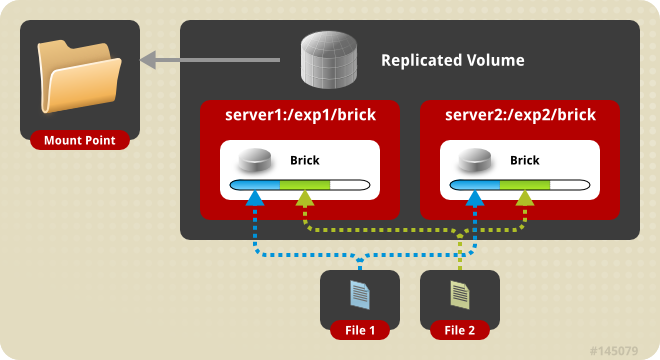6.4. Creating Replicated Volumes
Important
gluster volume create to create different types of volumes, and gluster volume info to verify successful volume creation.
A trusted storage pool has been created, as described in Section 5.1, “Adding Servers to the Trusted Storage Pool”. Understand how to start and stop volumes, as described in Section 6.10, “Starting Volumes”.
6.4.1. Creating Two-way Replicated Volumes
Figure 6.2. Illustration of a Two-way Replicated Volume
- Run the
gluster volume createcommand to create the replicated volume.The syntax is# gluster volume create NEW-VOLNAME [replica COUNT] [transport tcp | rdma | tcp,rdma] NEW-BRICK...The default value for transport istcp. Other options can be passed such asauth.alloworauth.reject. See Section 8.1, “Configuring Volume Options” for a full list of parameters.Example 6.3. Replicated Volume with Two Storage Servers
The order in which bricks are specified determines how bricks are replicated with each other. For example, every2bricks, where2is the replica count forms a replica set. If more bricks were specified, the next two bricks in sequence would replicate each other. The same is illustrated in Figure 6.2. Illustration of a Replicated Volume.gluster volume create test-volume replica 2 transport tcp server1:/exp1/brick server2:/exp2/brick Creation of test-volume has been successful Please start the volume to access data.
# gluster volume create test-volume replica 2 transport tcp server1:/exp1/brick server2:/exp2/brick Creation of test-volume has been successful Please start the volume to access data.Copy to Clipboard Copied! Toggle word wrap Toggle overflow - Run
# gluster volume start VOLNAMEto start the volume.gluster volume start test-volume Starting test-volume has been successful
# gluster volume start test-volume Starting test-volume has been successfulCopy to Clipboard Copied! Toggle word wrap Toggle overflow - Run
gluster volume infocommand to optionally display the volume information.
Important
6.4.2. Creating Three-way Replicated Volumes
Figure 6.3. Illustration of a Three-way Replicated Volume
The recommended configuration for three-way replication is to have a minimum of three nodes, as only a single brick out of the replica set is involved in syncing the files to the slave. It is expected that, all the bricks of a replica set are in different nodes. It is recommended not to have a brick along with its replica set from the same volume residing in the same node.
- Run the
gluster volume createcommand to create the replicated volume.The syntax is# gluster volume create NEW-VOLNAME [replica COUNT] [transport tcp | rdma | tcp,rdma] NEW-BRICK...The default value for transport istcp. Other options can be passed such asauth.alloworauth.reject. See Section 8.1, “Configuring Volume Options” for a full list of parameters.Example 6.4. Replicated Volume with Three Storage Servers
The order in which bricks are specified determines how bricks are replicated with each other. For example, everynbricks, wherenis the replica count forms a replica set. If more bricks were specified, the next three bricks in sequence would replicate each other. The same is illustrated in Figure 6.2. Illustration of a Replicated Volume.gluster volume create test-volume replica 3 transport tcp server1:/exp1/brick server2:/exp2/brick server3:/exp3/brick Creation of test-volume has been successful Please start the volume to access data.
# gluster volume create test-volume replica 3 transport tcp server1:/exp1/brick server2:/exp2/brick server3:/exp3/brick Creation of test-volume has been successful Please start the volume to access data.Copy to Clipboard Copied! Toggle word wrap Toggle overflow - Run
# gluster volume start VOLNAMEto start the volume.gluster volume start test-volume Starting test-volume has been successful
# gluster volume start test-volume Starting test-volume has been successfulCopy to Clipboard Copied! Toggle word wrap Toggle overflow - Run
gluster volume infocommand to optionally display the volume information.
Important

